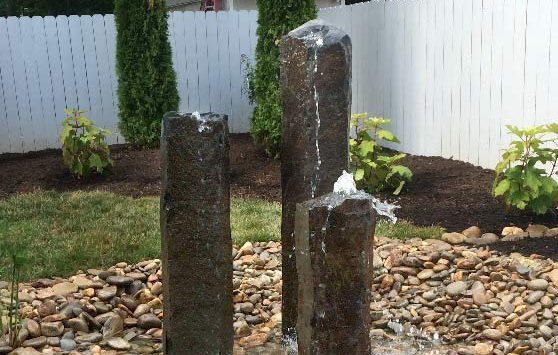Did you know that the fountain and rock garden on the middle school campus are more than just decorative landscaping? In fact, these attractive features of the Tate’s School campus serve an important function to our campus by collecting the stormwater that is generated from the roofs of the Studio and Art Room when it rains, and using that water for the fountain and surrounding plants.
In a natural setting, rain falls on trees, shrubs, grasses, rocks, and soil. It either evaporates from plant leaves and the earth’s surface, or it soaks into the soil, where it recharges groundwater or is used by the plants. Very little stormwater runoff occurs in a natural setting, and usually only during very heavy storms. When hard surfaces such as buildings and pavement are constructed, they change the way that rainfall is managed. Significantly more runoff is generated. The water runs over roads, parking lots and lawns collecting pollutants like gasoline, oils, grease, brake dust, fertilizers, herbicides, and pesticides. This dirty stormwater moves quickly to pipes and ditches which carry it as fast as possible to a local stream or river. This large increase of dirty, fast-moving stormwater can lead to stream pollution and erosion, and downstream flooding.
The Tate’s School fountain changes that cycle. Together, the fountain, rock garden and building downspouts create a cistern, which is a fancy word for a tank or reservoir that collects and stores water (usually rainwater) for another use. As you can imagine, cisterns have probably been used as long as man has walked the earth, collecting and storing rainwater to use for drinking water. Lately however, cisterns are growing in popularity as devices that manage rainfall as close as possible to where it falls, thus preventing the generation of dirty, fast-moving stormwater. Cisterns come in many forms and size and have a variety of uses – providing water for toilet flushing to gardening/landscaping to water feature decoration.
In the worlds of civil engineering and landscape architecture, cisterns are part of a larger group of rainfall management devices that are collectively called Green Infrastructure. The cistern at Tate’s School is one of only a handful of green infrastructure devices that exist in Knox County at this time. That is changing however, as engineers and landscape architects are beginning to see the benefits of such devices for land developments beyond stormwater management.
Contributed By Mary Halley, P.E., Water Resources Consultant



